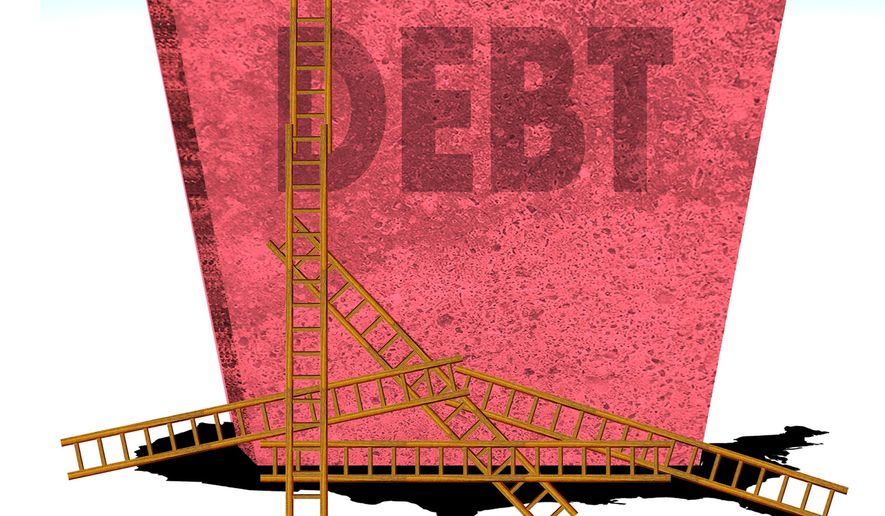OPINION:
Americans are enduring another episode of debt ceiling demagoguery.
Conservative House Republicans are demanding spending cuts to raise the $31.4 trillion limit, President Biden refuses to negotiate, and Treasury Secretary Janet Yellen threatens default on the national debt.
The Treasury collects less in taxes than it spends. For fiscal 2023, the shortfall is projected at 22% of spending.
Across cycles of expansion and macroeconomic crises — such as the 2007-2008 financial meltdown, the pandemic and the war in Ukraine — the national debt grows more rapidly than the U.S. economy.
Under current legislation and justifiable assumptions about economic growth, the debt held by the public — including that purchased by the Federal Reserve to print money — will grow from 98% of gross domestic product to 185% in 2052.
On that path, the United States won’t default — the Treasury can print bonds, and the Fed will buy some of those to keep interest rates low enough to sustain employment — but the United States will become like the United Kingdom.
British Prime Minister Rishi Sunak is coping with much higher inflation, union strikes and a health care crisis that really requires 110% of GDP to resolve and keep British living standards from a death spiral. At some point, the country hits a wall imposed by financial markets, as the budget plans of his predecessor, Liz Truss, demonstrated.
Entitlements are about 64% of federal spending, and interest payments are about 9%. That leaves only 27% for defense and other discretionary programs — everything from the departments of Transportation, Education and Defense to U.S. embassies abroad.
The hard left and right in the House have reservations about funding the war in Ukraine and overall defense spending. Military retirements and personnel practices need an overhaul, but whatever savings are obtained are required to beef up the Navy for threats posed by China and defending Taiwan.
The morass of outdated computer systems, backlog of returns and unanswered phone calls at the IRS bear witness to years of austerity imposed on non-defense discretionary spending.
Entitlement reform is where the money is. We don’t need to give food stamps and Medicaid to adults who won’t work and blank checks to universities through student loans. Still, you can’t get most Republicans within throwing distance of a competitive election to run on entitlement reform.
The hard left in the Democratic Party has embraced an interpretation of new monetary theory, which posits that federal deficits can be financed by printing money but look outside. In 2022, massive overspending, deficits and inflation offered a New Haven preview of the sequel to the Broadway hit “Hamilton” — the not-so-great Britainization of America.
Mr. Biden has a facile disposition — as a senator, he voted for the Defense of Marriage Act and against raising the debt ceiling — but now appears captive to hard-left progressives.
House Speaker Kevin McCarthy is held hostage by the Freedom Caucus and can’t release a vote on the debt ceiling that doesn’t slash spending.
For the speaker, the way out is to encourage more moderate leaders in the Republican House majority to negotiate a compromise on entitlement and other spending with willing House Democrats and senators from both parties.
If those problem solvers can cobble a compromise appealing to moderates in both parties, they could get a House vote via a discharge petition. And hopefully get a Senate vote out of Majority Leader Chuck Schumer.
Alternatively, moderates could embrace centrist Democratic Sen. Joe Manchin’s proposal for a bipartisan commission on entitlement reform, but only if it has teeth.
The commission’s mandate should include drafting a bill within 120 days that includes specific savings and annual entitlement spending ceilings for the next decade. Attach that draft legislation to a bill raising the debt ceiling by a modest amount and require an up or down vote on the commission’s reform bill.
The president could take it or let the country run out of money when extraordinary measures expire around June.
The federal government defaults only if the president and Ms. Yellen are not doing their jobs.
The debt ceiling must be raised to finance new spending, but past spending has been paid for by the debt already outstanding.
The federal government would have 78% of what it needs to pay its bills. Mr. Biden could declare a state of emergency and prioritize.
Existing debt could be rolled over — new bonds would replace those redeemed — and interest on the debt must be paid. That would leave about 69% of fiscal 2023 spending.
Prioritizing does require contingency plans at the Treasury to decide which bills get paid — Social Security checks and Medicare and Medicaid bills for sure, but food stamps and other entitlements could be trimmed.
What occurs would look like past government shutdowns. Those were not pretty, but they didn’t end the world as we know it. Ultimately, U.S. borrowing capacity was sustained, and enough of our elected officials got reasonable enough to work out compromises.
• Peter Morici is an economist and emeritus business professor at the University of Maryland, and a national columnist.




Please read our comment policy before commenting.